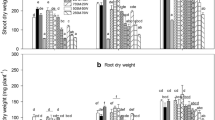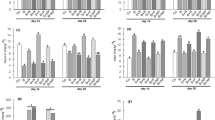Summary
A loam soil containing an organic fraction labelled with15N was used for pot experiments with spring barley, rye-grass and clover. The organically bound labelled N was mineralized at a rate corresponding to a half-life of about 9 years.
Fertilization with 106 and 424 kgN/ha of unlabelled N in the form of KNO3 significantly increased uptake of labelled N from the soil in barley and the first harvest of rye-grass crops. The fertilized plants removed all the labelled NH4 and NO3 present in the soil, whereas the unfertilized plants removed only about 80%.
The second, third and fourth harvests of the unfertilized rye-grass took up more labelled N than the fertilized rye-grass. The total uptake in the four harvests was similar whether the plants were fertilized or not.
Application of KCl to barley plants in amounts equivalent to that of KNO3 resulted in a small but insignificant increase in uptake of labelled N.
The uptake of labelled N in the first harvest of clover which was not fertilized but inoculated with Rhizobium was similar to that of the fully fertilized rye-grass indicating that the biological fixation of N had the same effect as addition of N-fertilizer. N uptake in the following harvests was lower and the total uptake by four harvests of clover was similar to that of rye-grass.
There was no indication that fertilization with KNO3 accelerated the mineralization of the organically bound labelled N. The observed apparent ‘priming effect’ of the fertilizer on the uptake of labelled N was compensated by subsequent crops and harvests, and it seems to arise from a more thorough search of the soil volume by a better developed root system of the fertilized plants.
Similar content being viewed by others
References
Bremner J M 1965 Total nitrogen.In Methods of Soil Analysis. Ed. C A Black. Part 2, pp 1149–1178. Am. Soc. Agron., Madison, Wis., U.S.A.
Bremner J M 1965 Inorganic forms of nitrogen.In Methods of Soil Analysis. Ed. C A Black. Part 2, pp 1179–1237, Am. Soc. Agron., Madison, Wis., U.S.A.
Bremner J M 1965 Organic forms of nitrogenIn Methods of Soil Analysis. Ed. C A Black. Part. 2, pp. 1238–1255. Am. Soc. Agron., Madison, Wis., U.S.A.
Fiedler R and Proksch G 1975 The determination of nitrogen-15 by emission and mass spectrometry in biochemical analysis: a review. Anal. Chim. Acta 78, 1–62.
Hauck R D and Bremner J M 1976 Use of tracers for soil and fertilizer nitrogen research.In Advances of Agronomy. Ed. N C Brady. Vol. 28, pp. 219–266. Academic Press, New York, U.S.A.
Jansson S L 1971 Use of15N in studies of soil nitrogen.In Soil Biochemistry. Eds. A Douglas McLaren and J Skujins. Vol. 2, 129–166. Marcel Dekker, Inc., New York, U.S.A.
Author information
Authors and Affiliations
Rights and permissions
About this article
Cite this article
Sørensen, L.H. Mineralization of organically bound nitrogen in soil as influenced by plant growth and fertilization. Plant Soil 65, 51–61 (1982). https://doi.org/10.1007/BF02376802
Received:
Revised:
Issue Date:
DOI: https://doi.org/10.1007/BF02376802




